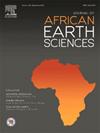The potential of object-based classification for geological mapping: Applications to the volcanic region of Vakinankaratra (central Madagascar)
IF 2.2
4区 地球科学
Q2 GEOSCIENCES, MULTIDISCIPLINARY
引用次数: 0
Abstract
A geological map is an indispensable instrument in the field of geological research. In the past, the sole method employed for the production of geological maps was manual mapping. This approach is costly in terms of time, resources and the amount of work required. Since the conclusion of the 20th century, remote sensing techniques, which entail the classification of satellite images, have been employed for the purpose of geological mapping to complement field work. The pixel method, which classifies based on pixels, is the most prevalent approach for the production of geological maps due to its greater ease of implementation. In contrast, object-based classification methods which consider sets of pixels (objects), are seldom employed, despite their considerable potential for geological mapping. The aim of this article is to compare the performance of these two types of satellite image classification for the update of geological maps (pixel and object-based method). The Central Highlands of Madagascar region has diverse geological, volcanic, sedimentary and metamorphism formations. The richness of geological features make harder geologic mapping. The use of Sentinel-1 and 2 images was justified by their superior accuracy and a high spatial resolution, permitting an easier details highlighting. The object-based method yielded geological map of notable accuracy, a slight superior Kappa coefficient (0.88 vs. 0.83). The generated map exhibit greater homogeneity and are more readily interpretable. Enabling, more straightforward identification of the different lithologies and easier geodynamic history comprehension of the study area.

求助全文
约1分钟内获得全文
求助全文
来源期刊

Journal of African Earth Sciences
地学-地球科学综合
CiteScore
4.70
自引率
4.30%
发文量
240
审稿时长
12 months
期刊介绍:
The Journal of African Earth Sciences sees itself as the prime geological journal for all aspects of the Earth Sciences about the African plate. Papers dealing with peripheral areas are welcome if they demonstrate a tight link with Africa.
The Journal publishes high quality, peer-reviewed scientific papers. It is devoted primarily to research papers but short communications relating to new developments of broad interest, reviews and book reviews will also be considered. Papers must have international appeal and should present work of more regional than local significance and dealing with well identified and justified scientific questions. Specialised technical papers, analytical or exploration reports must be avoided. Papers on applied geology should preferably be linked to such core disciplines and must be addressed to a more general geoscientific audience.
 求助内容:
求助内容: 应助结果提醒方式:
应助结果提醒方式:


